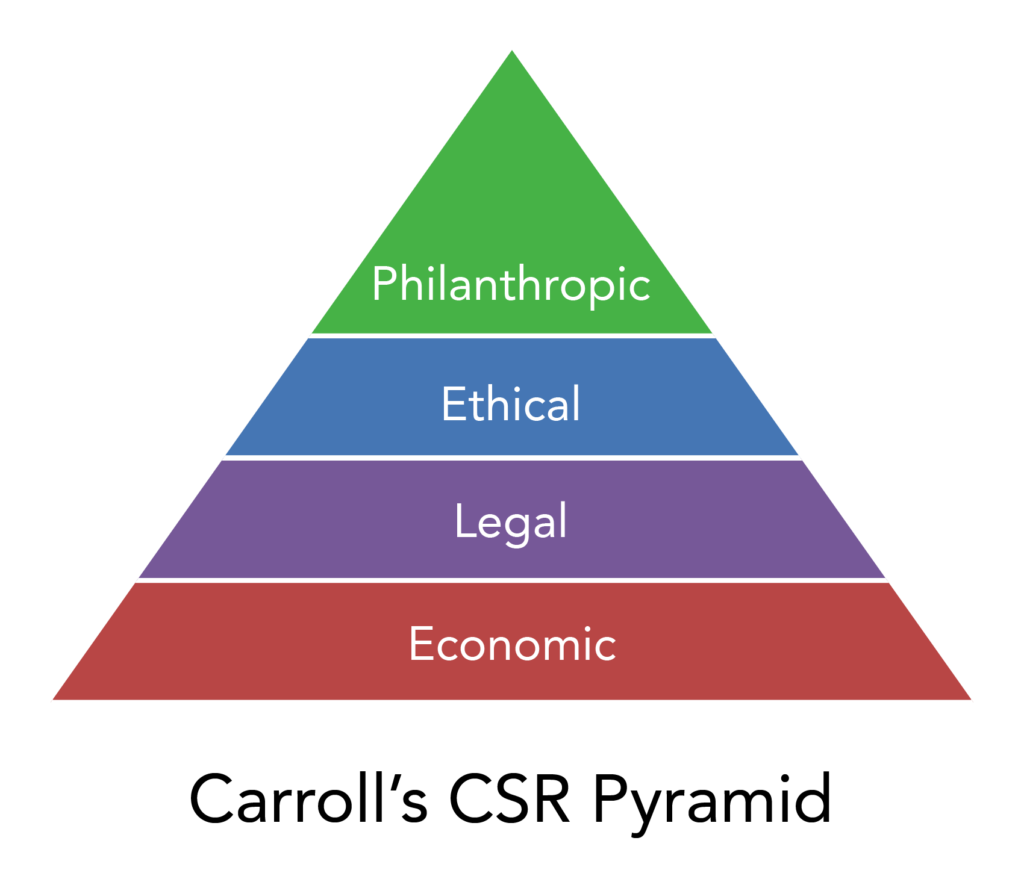17.1: What is Corporate Social Responsibility?
- Page ID
- 47180
- Discuss corporate social responsibility

Corporate social responsibility, or CSR, is a corporation’s obligation to its stakeholders, including employees, clients/customers, investors and the community or communities where it’s based or operates. Although many businesses take that obligation to heart, CSR has also been used for damage control, as a smoke screen and simply to generate media mentions (PR). The framework for CSR as a practice was articulated by business management author and professor Dr. Archie Carroll in his 1991 article “The Pyramid of Corporate Social Responsibility” (available as a free download from researchgate.net).[1] In this article, Dr. Carroll summarizes the evolution of executive thinking on the responsibility of a corporation to society, from maximizing financial return to shareholders to an understanding of an organization’s obligation to conform to applicable laws and, ultimately, due to the passage of social legislation and creation of related enforcement agencies, including the Environmental Protection Agency (EPA), Equal Employment Opportunity Commission (EEOC), Occupational Safety & Health Administration (OSHA) and Consumer Product Safety Commission (CPSC), a recognition that the environment, employees and consumers are “significant and legitimate stakeholders of business.”

To put these obligations in perspective, Caroll proposed a pyramid of corporate social responsibility with four levels, from the base to the top: economic, legal, ethical and philanthropic. A business’ first responsibility—economic, at the base—is to be profitable. This is generally interpreted broadly: to create useful products and services, to create jobs that pay a fair wage, to maintain a strong competitive position and a high level of operating efficiency and to provide a return on investment to owners and shareholders. The second level—legal—reflects a business’ responsibility to obey the law. Specifically, a business is expected “to perform in a manner consistent with expectations of government and law,” complying with relevant laws, fulfilling legal obligations and providing goods and services that at least meet minimal legal requirements. The third level is ethical responsibility, which Caroll describes as performing “in a manner consistent with expectations of societal and ethical norms,” noting that “it is important to recognize that corporate integrity and ethical behavior go beyond mere compliance with laws and regulations.”[2] Ethics is generally interpreted as “doing the right thing,” even if it’s not required by law. At the top of the pyramid is philanthropic responsibility. This is also referred to as discretionary responsibility and includes the range of actions associated with being a good global citizen from supporting arts and culture and education, participating in volunteer and charitable activities and other initiatives that contribute to a community’s quality of life.
The concept of CSR has enlarged in recent years, with CSR being defined more broadly to encompass the full range of responsibilities a business has to society. For example, you will find multiple descriptions of CSR as a commitment to managing the social, environmental and economic effects of a business which is, of course, the working definition of sustainability. Indeed, Business News Daily describes CSR as “an evolving business practice that incorporates sustainable development into a company’s business model.”[3]
Ultimately, it doesn’t matter whether you approach corporate responsibility from a sustainability perspective or as a CSR initiative that incorporates sustainability. What’s important is to understand the context and the business relevance of CSR. As with sustainability, CSR activities help businesses cultivate a positive perception (brand image) with employees, consumers, the community and NGO and regulatory organization. As Investopedia notes, “CSR activities can help forge a stronger bond between employee and corporation; they can boost morale and can help both employees and employers feel more connected with the world around them.”[4]
- Carroll, Archie B. "The Pyramid of Corporate Social Responsibility: Toward the Moral Management of Organization Stakeholders." 1991. Accessed July 18, 2019. ↵
- Ibid. ↵
- Schooley, Skye. "What is Corporate Social Responsibility?" Business News Daily. April 22, 2019. Accessed July 18, 2019. ↵
- Chen, James. "Corporate Social Responsibility (CSR)." Investopedia. February 11, 2019. Accessed July 18, 2019. ↵
Contributors and Attributions
- Image: Caroll's CSR Pyramid. Provided by: Lumen Learning. License: CC BY: Attribution
- Untitled. Authored by: Gerd Altmann. Provided by: Pixabay. Located at: pixabay.com/illustrations/road-sign-attention-right-of-way-63983/. License: CC0: No Rights Reserved. License Terms: Pixabay License


